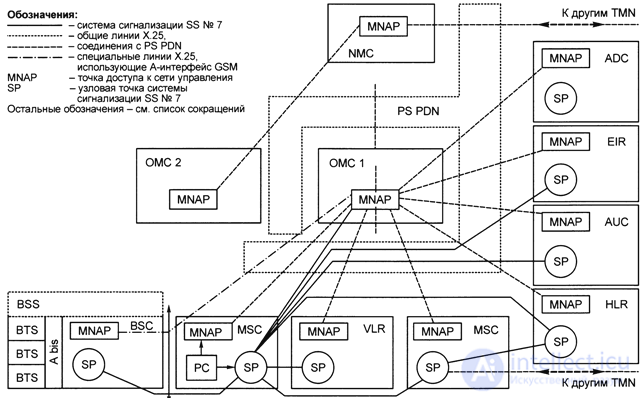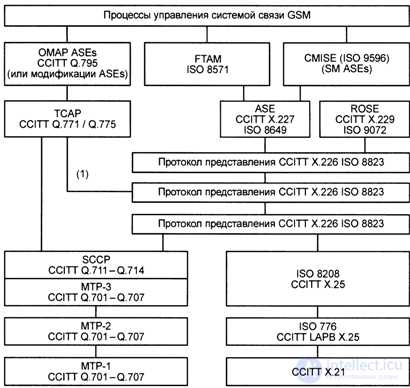Lecture
Standard interfaces in the network management system provide interaction between network elements, operating systems and workstations through data networks or local communication networks. To guarantee the joint operation of the network elements to be connected, clear technical requirements for the interface, functionally independent of the type of device and the supplier, are required. This requires compatible communication protocols and a compatible presentation method for transmitting messages, including compatible group message descriptions for control network functions.
The composition and functionality of the interfaces in GSM TMN are shown in fig. 9.2.
The CCITT SS No. 7 or X.25 signaling system is used to transmit messages between control networks used, for example, by different operators. When using SS№7, CCITT protocols (Blue Book), recommendation Q.795 [9.4] are used. When using X.25 networks, additional agreements are required between operators on the use of higher-level protocols. Some network management functions are defined by CEPT working group SPS 6 in the recommendation GSM 09.02 [11.5], which requires the use of SS No. 7 in the following cases:

Fig. 9.2. Interfaces GSM TMN.
In general, network operators are free to use either the SS No. 7 signaling system provided for in the PLMN or the specialized X.25 network in accordance with the recommendations of CCITT (Blue Book) Q.513 [9.6]. When using X.25 networks, tools may be needed to convert the exchange protocols (X.25 - SS No. 7).
Information exchange in the network management process between the BSS and the MSC (A-Interface, Fig. 9.3) is provided by SS No. 7.

Fig. 9.3. Information exchange in the network management process between the BSS and MSC
Requirements for file exchange facilities are provided using SCCP class 2 and X.224 class 2 transport protocol, or SCCP class 3 and X.224 class 0. A special GSM version is also provided concerning the use of X.25 connections on the A-interface. The interface between BTS and BSC (GSM A-bis interface) is based on the use of LAPD protocols for information exchange in network management. All PLMN nodes, with the exception of BTS, are equipped with a common X.25 interface. This provides full access to TMN Level 3, either locally or remotely by using a separate connection to the PS PDN. When using local networks in PLMN, the TMN interfaces are defined by the CEP recommendation T / C 02-11 [9.7]. The full block diagram of the GSM communication system management processes, the composition and interfaces of the communication protocols are shown in fig. 9.3.
Interfacing at higher levels (above level 3) can be provided using standard protocols based on recommendations (Blue Book) CCITT Q.795 or ISO standards for Common Information Management Services (CMIS) and Access and File Exchange Management (FTAM) as illustrated in fig. 9.3 [9.8, 9.9]. However, at the first stage, the use of OMAR in GSM TMN is not recommended, since it requires a network service without connections, which cannot be supported by SS No. 7 and X.25. In addition, file exchange methods that are mandatory for the effective management of PLMN are not fully defined in the OMAR.
Comments
To leave a comment
GSM Basics
Terms: GSM Basics